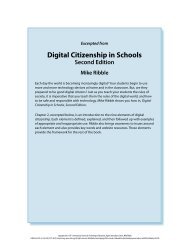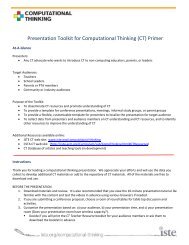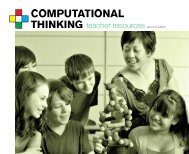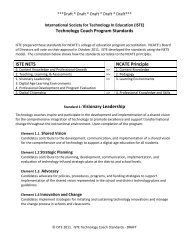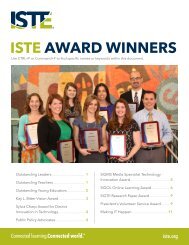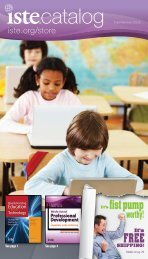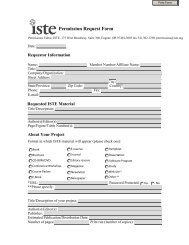ISTE Learning New books coming soon
ISTE Learning New books coming soon
ISTE Learning New books coming soon
You also want an ePaper? Increase the reach of your titles
YUMPU automatically turns print PDFs into web optimized ePapers that Google loves.
edition of this perennial favorite offers dozens of new lessons<br />
ion activities that demonstrate how flexible a teaching tool the<br />
readsheet can be. Spreadsheets are ubiquitous in higher education<br />
ofessional world, so learning to create and manipulate these<br />
s is an essential skill for today’s students. But Spreadsheet Magic<br />
t they are also a great way for young people to learn basic math,<br />
d language arts concepts. This book offers you everything you<br />
corporate spreadsheets in your K–6 classroom: an introduction<br />
readsheet functions and capabilities, step-by-step activity<br />
s keyed to the NETS•S and content area standards, teaching<br />
tension ideas for promoting higher order thinking skills, and a<br />
with a complete set of modifiable lesson templates and samples.<br />
ctory chapters discuss classroom applications for spreadsheets<br />
practical, original, and fun.<br />
es are sorted by grade level and can be modified to accommodate<br />
ange of abilities and learning styles.<br />
can be adapted easily to enlist parents and other volunteers as<br />
m instructional assistants.<br />
OGY: FEATURES:<br />
AUDIENCE:<br />
ovide Introduction to Grade K–6 teachers<br />
strucsing<br />
Excel and functions<br />
spreadsheet features<br />
Computer lab<br />
instructors<br />
ts in the<br />
40 ready-to-use<br />
but all<br />
Technology and<br />
lesson plans for<br />
an easily<br />
curriculum coordinators<br />
grades K–6<br />
lished<br />
Preservice teachers<br />
spreadram.<br />
preparation,<br />
Tips for lesson<br />
contains assessment, and<br />
set of instructional support<br />
plates and<br />
Excel.<br />
5/30/06 2:07:09 PM<br />
Backlist<br />
▸ Table of Contents<br />
Spreadsheet Magic<br />
Second Edition<br />
Student-Powered Podcasting<br />
Teaching for 21st-Century Literacy<br />
agic is in the <strong>Learning</strong>!<br />
w.iste.org<br />
CD<br />
By Pamela Lewis<br />
$39.95. 194 pp. 2006. 978-1-56484-224-4<br />
Product code: SPRED2-1002<br />
Member price: $27.97<br />
“Features lessons that anyone can feel confident implementing<br />
in their K–6 classroom.”<br />
—NCS-Tech<br />
Dozens of new lessons and activities enrich the second edition<br />
of this popular favorite, establishing proof of just how flexible and<br />
effective the humble spreadsheet can be as a teaching tool.<br />
Audience: Educators (K–6), computer lab educators, technology<br />
coordinators, curriculum specialists, preservice educators<br />
Features: Comprehensive introduction to using spreadsheets<br />
in the classroom; 40 ready-to-use lesson plans for grades K–6;<br />
tips for lesson preparation, assessment, and instructional support<br />
e<br />
book<br />
By Christopher Shamburg<br />
$32.95. 193 pp. 2009. 978-1-56484-261-9<br />
Product code: PODHUM-1002<br />
Member price: $23.07<br />
“A must for any technology education class.”<br />
—Midwest Book Review<br />
Educators of all experience levels will discover how to use<br />
podcasting as a vehicle for curriculum reform. Audio-editing<br />
tutorials and 17 standalone podcasting units allow you and<br />
your students to dive right into podcasting.<br />
Audience: Educators (K–12), library media specialists,<br />
teacher educators<br />
Features: Seventeen adaptable podcasting units on a variety<br />
of topics; discussions on legal and ethical considerations, a<br />
copyright and fair use quiz, and a set of podcasting rules for the<br />
classroom; assessment rubrics correlated to a variety of national<br />
standards<br />
Teaching with Digital Images<br />
Acquire, Analyze, Create, Communicate<br />
Teaching with Digital Video<br />
Watch, Analyze, Create<br />
Edited by Glen L. Bull and Lynn L. Bell<br />
$37.95. 179 pp. 2005. 978-1-56484-219-0<br />
Product code: DIGIMA-1002<br />
Member price: $26.57<br />
Edited by Glen L. Bull and Lynn L. Bell<br />
$37.95. 179 pp. 2010. 978-1-56484-266-4<br />
Product code: DIGVID-1002<br />
Member price: $26.57<br />
CD<br />
Subject-area experts demonstrate how to use digital cameras<br />
for data collection, scientific visualization, mathematical analysis,<br />
and digital storytelling.<br />
Audience: Educators (K–8), administrators (K–8), technology<br />
coordinators, library media specialists, curriculum specialists<br />
Features: Introductory chapters on digital photography basics<br />
and image editing software; individual chapters on the use of<br />
digital cameras in math, science, language arts, and social<br />
studies classrooms; lesson plans; teaching tips; classroom<br />
management strategies<br />
e<br />
book<br />
“Superbly organized and presented, Teaching with Digital Video:<br />
Watch, Analyze, Create is an extraordinary instructional guide and<br />
highly recommended.”<br />
—Midwest Book Review<br />
This book approaches digital video use by subject, showing<br />
educators how to effectively use digital video in four core<br />
curriculum areas.<br />
Audience: Educators (K–12), technology coordinators, library<br />
media specialists, curriculum specialists<br />
Features: Activities and resources for incorporating digital<br />
video into science, social studies, English language arts, and<br />
math lessons; directions for creating and acquiring digital video;<br />
aligned to NETS•S and subject-area standards<br />
The Technology Coordinator’s Handbook<br />
By Max Frazier and Gerald Bailey<br />
$31.95. 178 pp. 2004. 978-1-56484-211-4<br />
Product code: TCHAND-1002<br />
Member price: $22.37<br />
This handbook offers a detailed introduction to the roles and<br />
functions performed by tech coordinators, the key issues they<br />
face, and the basic skills and qualifications they need to fulfill<br />
their responsibilities.<br />
Audience: Technology coordinators, network managers,<br />
administrators, college of education faculty, college of education<br />
administrators<br />
Features: Comprehensive discussion of the technology<br />
coordinator’s role in K–12 schools and districts; examination<br />
of each of the essential skills and qualifications needed for<br />
technology leadership; resources for professional development<br />
and certification, grant writing, and E-rate filing<br />
The Technology Director’s Guide<br />
to Leadership<br />
The Power of Great Questions<br />
By Don Hall<br />
$31.95. 212 pp. 2008. 978-1-56484-244-2<br />
Product code: TDLEAD-1002<br />
Member price: $22.37<br />
Don Hall provides leadership exercises and strategies to help<br />
guide technology directors through the roles of leaders and<br />
agents of change.<br />
Audience: Technology directors, administrators, teacher<br />
educators<br />
Features: A discussion of leadership styles, suggestions for<br />
managing different personality types, more than a dozen practical<br />
activities and exercises<br />
27




